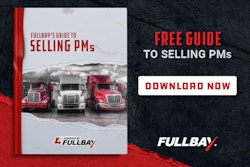
Whether managing freight networks or building trucks, it seems everyone’s in the same boat: the market is in flux, driven by trade policy volatility and shifting regulatory environments.
J.B. Hunt (CCJ Top 250, No. 3) and Mack Trucks executives at the 2025 FTR Transportation Conference this week emphasized the role of proactive planning and flexibility to adapt to market conditions.
Impact of tariffs on truck production costs and freight flows
Tariffs, particularly on raw materials and the possibility of additional duties on medium- and heavy-duty trucks and parts imports, combined with an extended freight recession, have put pressure on Mack Trucks to rethink their strategies, said company president Jonathan Randall.
Mack, a Volvo Group subsidiary, is at a disadvantage compared to competitors with Mexico-based plants, as the company and its suppliers rely on U.S. imports and therefore pay tariffs that others can avoid.
“We built everything in the U.S., all our trucks, engines and transmissions. And what we found as a result is we are actually disadvantaged today versus some (manufacturers) that are producing in Mexico. We don’t produce there, at least not yet.” Randall said.
Mack Trucks are manufactured in the U.S., though Volvo announced plans for an assembly facility in Mexico in 2026.
The company had already implemented a tariff surcharge for production this year. While it doesn’t cover the cost of the entire unit, Randall said, “We had to do something at least to compensate for some of the costs.”
Randall said Mack doesn’t disclose the cost impact of the tariffs; however, Dan Moyer, FTR senior analyst for commercial vehicles, put the overall rise in Class 8 production costs since early 2025 at between 15% and 24%, driven largely by tariffs.
In addition, tariff volatility continues to dampen customer sentiment and impact operational uncertainty.
J.B. Hunt EVP of Sales and Marketing Spencer Frazier said that the number one question that customers are asking is, “What should I plan for 2026?”
Shifting tariff policies and the resulting supply chain disruptions have made customers deploy various strategies, said Frazier. Customers accelerated imports before tariff implications, while some modified sourcing and distribution networks. Other strategies included accelerating, postponing, and rerouting shipments. These actions have led to increased shipment volumes and directions, causing some imbalances.
However, Frazier noted that most of these effects have started to normalize recently.
Regulatory issues
The industry is also grappling with uncertainty surrounding the EPA27 emissions rules, which are currently under review by the U.S. Environmental Protection Agency.
That review has flipped expectations of a pre-buy surge, Randall said, as fleets would normally order trucks ahead of stricter and more expensive regulations.
The review could have three possible outcomes, Randall said. The EPA could stick with the proposed 0.035 g/NOx limit along with stricter aftertreatment warranty requirements, keep the 0.035 g/NOX threshold but lessen warranty rules, or hold the current 0.2g/NOx standard.
J.B. Hunt’s Frazier also pointed out that the enforcement of existing or new regulations can potentially accelerate and impact the supply side of the industry faster than in the past.
There’s also a rising cost burden of regulatory compliance, Frazier pointed out. Compliance and safety costs—including equipment, healthcare, and especially insurance—are rising, Frazier said. Safety operations are especially critical to manage insurance costs, he said.
Adapting quickly to regulatory changes, maintaining close relationships with partners, and investing in technology and safety are needed to address these pressures, Frazier added.
Long-term planning
There’s a shared focus on scenario planning, underscoring the industry’s sentiment of trying to anticipate and prepare for significant shifts.
Transparency and proactive planning to help customers navigate the evolving regulatory environment are critical, Frazier said. “Just being transparent (with clients) and then saying, ‘How do we address that together?’ It’s about finding more efficient ways to move the products across customer supply chains.”
As they plan long term, Frazier said they’re updating the company’s five-year plan and continuously adjusting based on market conditions—a tough task for a large fleet in a shifting environment.
Frazier said they keep a structured approach to managing transitions as they occur. “The one constant thing, which you all know, is that things are going to change, and so you have to be really good at communicating that.”
As for Mack, Randall said the company began its 2026 planning cycle about two months ago, adding that they have teams “doing the best they can to read the tea leaves” for shifting trade policies and regulatory paths.
As the company doesn’t anticipate a rebound in Class 8 demand until Q4 2026, Randall said scenario planning is central to their approach.
He added that fleets are cautious to place orders—a tough backdrop as Mack rolled out two new tractors (new flagship Class 8 model Pioneer in April, and redesigned regional-haul tractor Anthem in September).













